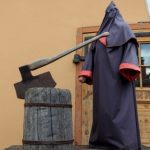 Weird Stuff
Weird Stuff  Weird Stuff
Weird Stuff  Mysteries
Mysteries 10 Tragic Disappearances and Deaths in Joshua Tree National Park
 History
History 10 Ways Childhood Really Sucked in the Old West
 Music
Music 10 Name Origins of Famous Bands from the 1990s
 Religion
Religion 10 Biggest Turnarounds by the Catholic Church
 Weird Stuff
Weird Stuff 10 Unbelievable Times Laws Had Unintended Consequences
 Humans
Humans Ten Historic Women Who Deserve Way More Credit Than They Got
 Movies and TV
Movies and TV 10 Films That Spawned Major Lawsuits
 History
History Ten Times Towns Were Wiped Off the Face of the Earth
 Creepy
Creepy 10 of the Most Disturbingly Haunted Public Houses in the UK
 Weird Stuff
Weird Stuff 10 Niche Subcultures That Are More Popular Than You Might Think
 Mysteries
Mysteries 10 Tragic Disappearances and Deaths in Joshua Tree National Park
 History
History 10 Ways Childhood Really Sucked in the Old West
Who's Behind Listverse?

Jamie Frater
Head Editor
Jamie founded Listverse due to an insatiable desire to share fascinating, obscure, and bizarre facts. He has been a guest speaker on numerous national radio and television stations and is a five time published author.
More About Us Music
Music 10 Name Origins of Famous Bands from the 1990s
 Religion
Religion 10 Biggest Turnarounds by the Catholic Church
 Weird Stuff
Weird Stuff 10 Unbelievable Times Laws Had Unintended Consequences
 Humans
Humans Ten Historic Women Who Deserve Way More Credit Than They Got
 Movies and TV
Movies and TV 10 Films That Spawned Major Lawsuits
 History
History Ten Times Towns Were Wiped Off the Face of the Earth
 Creepy
Creepy 10 of the Most Disturbingly Haunted Public Houses in the UK
10 of History’s Most Iconic Hiders
I’m sure you all wish you had a little spot, a room, a boat, or a basement where nobody could find you and you could outrun your problems. Perhaps you envision something that resembles a man cave with a bar, sports flags, and cable television. Maybe a massage chair with a humidifier and some scented candles is more your thing. Whatever floats your boat, the idea of hiding from the world is appealing. A spot where our problems can’t follow.
Throughout history, many leaders and figures have had to hide, either from the forces of evil or perhaps from the extended arm of justice itself, lifting every rock to find where you might be hiding. Sometimes, these individuals spent a significant amount of time in their hideouts in the hopes of tasting freedom one day.
Here are ten of the most iconic hiders and the unique locations they chose to hide.
Related: 10 Famous Gangster Hideouts
10 Fidel Castro—Sierra Maestra Hideout
Fidel Castro was an unpopular man in the United States, almost spearheading the country into a nuclear war that would have shaken the foundations of the world. But before he became the bane of the West, he had a revolution to lead.
Being at odds with the reigning government puts a person in a somewhat precarious position. At odds with the forces of Fulgencio Batista, Castro and his second-in-command, Che Guevara, were forced to launch their revolution from deep in the Cuban Jungle from a secret location surrounded by the Sierra Maestra mountains. For roughly a year, they spent their time plotting their guerilla war while moving about the jungle, remaining under the radar. They eventually settled in La Plata.
La Plata, the final hideout of Fidel Castro, was so well hidden that Batista and his men never found it. Today, the Sierra Maestra, with its lush forestry, is a popular hiking destination.[1]
9 Saddam Hussein—Spider Hole
When George Bush’s America invaded Iraq in 2003, under the apparent threat that weapons of mass destruction might hold for the free world, Saddam Hussein became a moving target on the FBI’s most wanted list. However, Hussein was nowhere to be found.
On a farm south of Hussein’s hometown of Tikrit, with the aid of some loyalists, he hid from the authorities in a bunker-style hideout dug in the earth. The hole, known as the Spider Hole across the world, was no larger than an oversized grave, with enough space to sleep and sit up and nothing more. Nearby, in a basic far outhouse, they also found a fridge with hotdogs and cokes, as well as some $750,000 in $100 bills stashed in shoe boxes.
All in all, Hussein was on the run for 250 days, ducking into the Spider Hole whenever suspicion arose. In the end, his luck ran out, and someone ratted him out, leading to his capture.[2]
8 Harriet Tubman—Underground Railroad Safe Houses
Prominent abolitionist, humanist, and general badass lady of the American Civil War relied on many hiding places to escape and ultimately help others escape the terrible effects of slavery.
Harriet Tubman and her band of justice warriors created what was known as the Underground Railroad, an apt metaphor for a series of houses along a route through states where slavery was still practiced, all the way to those that were not (from Ohio over the river to Kentucky). The idea was to provide safe housing along this often treacherous route, and Tubman was one of the main cogs in this machine.
Tubman became a renowned conductor of the Underground Railroad, saving more than 300 people over ten years by hiding herself and those she helped rescue in their secret safe houses. Some of these houses have been preserved and can be viewed by the public today.[3]
7 John Wilkes Booth—Thickets and the Barn
When John Wilkes Booth shot Abraham Lincoln at point-blank range in his balcony seat at Ford’s Theater, there was a hoard of angry men on his tail, hoping to stick his head on a pike. To complicate matters for Booth, he had a massive bounty on his head.
Booth made a great escape from the theater on horseback, meeting up with his co-conspirator, David Herold. Together, they collected their previously stashed supplies, sought treatment for Booth’s broken leg, and began their escape from justice. They managed to hide in the pine thickets for days on end, hoping to cross the Potomac River into Virginia. That is until they heard a focused search had been launched in the area of Maryland where they were hiding.
They were hunted like wild animals until, finally, justice was served. Booth was caught hiding in a tobacco barn, where he refused to surrender. He was eventually shot and dragged from the barn by force.[4]
6 Osama Bin Laden—The Compound
The face of terrorism, the feared and revered mastermind of the 9/11 terror attacks on the United States, was a unique kind of evil, there is no doubt, but one thing you have to hand him—he knew how to hide.
With the whole U.S. Army combing deserts and lifting rocks for clues, Osama bin Laden managed to avoid being killed, shot at, or even seen by the U.S. forces for almost an entire decade while his fellow Al-Qaeda members waged war with the West. Hiding for such a long time while millions are spent in your pursuit is quite a feat.
In the end, bin Laden was tracked to a compound in Abbottabad, Pakistan, known as the “Waziristan Haveli” (meaning mansion), in which he was believed to have lived since 2006. For more than five years, he lived undisturbed until an American military operation spelled his end.[5]
5 Ann Frank—Annex
Ann Frank’s diary will live on in infamy as a symbol of the absolute dichotomy of terror combined with the resolve of a little girl in the most trying of times.
It was 1942, and the Frank family was forced to flee Germany to escape the rising Nazi fanaticism. They made their way to Amsterdam, which later also came under heavy attack from the German army. To avoid deportation, the Frank family (along with others) had no choice but to hide in a little annex, the entrance of which was covered by a bookcase while the war waged on outside.
For more than two years, Ann lived every minute of every day in the cramped space where she also penned her famous diary. In 1943, the house was sold, and another year later, they were discovered.[6]
4 Hiroo Onoda—The Philippine Jungle
When the war in the Pacific ended, and the American forces returned to their homes, the death count reached the thousands as the true extent of the war became clear. One such deceased soldier, Hiroo Onoda, an officer of the Imperial Japanese Army, never returned from the jungle and was declared dead in 1959.
The only thing is, Onada wasn’t dead. In fact, he was seeing out his duty of protecting the island from the invasion. In 1944, Onoda was stationed on a small island named Lubang in the Philippines. When they lost a battle with the West, Onada and his men were forced into the jungle where most of them only remained for a short few days. Onoda had other plans.
In the end, Onoda spent almost 30 years hiding in the jungle, believing that the war was still ongoing. It was only in 1974 that he returned from his hiding place to a hero’s welcome. His story has been turned into a memoir and a film.[7]
3 Ma Barker—Lakeside Hideout
For years, Ma Barker and her familial gang of bandits terrorized the population. As head of the Barker gang (also Karpis gang), Barker and her sons were responsible for a string of bank robberies, murders, and kidnappings, leading to the death of 10 people, including a police officer.
After being branded public enemy number one, the family retreated to Ocklawaha, a small town in Florida. The Barker family had not spent a long time hiding from the authorities before they were discovered. About two weeks, in fact. But what ensued once they had been found is what makes this hiding situation so unique.
After finding themselves surrounded by officers, Ma Barker agreed to what felt like a truce and surrender. What ensued was one of the most vicious gunfights you can imagine. The surrender saw the house riddled with thousands of bullet holes, dead officers, and then the end of the Barker gang. It’s known as the longest shootout to this day.[8]
2 Pablo Escobar
As the merciless leader of the Medellin gang, Pablo Escobar spent his final years in negotiations with the authorities, fighting court cases and hiding. A violation of his agreement with Colombian President César Gaviria, which allowed him to remain in his own home, saw him on the wanted list again.
Aided by the U.S., the Colombian government set out to put an end to Escobar’s reign, driving him into hiding. He had many hiding spots, but one of the most infamous was his luxury hideout in Tulum, Mexico, where he managed to stay under the radar. For more than a year, Escobar managed to avoid being discovered.
In the end, he was found in a middle-income residential area in Medellin, where he was shot and killed. His Tulum mansion has since been turned into a luxury hotel where you can spend the night.[9]
1 Joseph Kony—Somewhere in African Jungle
In 2005, an arrest warrant was issued by the International Criminal Court for the arrest of Joseph Kony, head of the Lord Resistance Army. He was wanted for 33 counts of war crimes against humanity, spanning torture, murder, and kidnapping of children and using them in his own personal army.
The world knew of his antics, and the West became involved with finding Kony and bringing him to task, hopeful that some of the captured children might also be saved. It has been many years, and there have been many attempts to find him, to no avail.
To this day, Kony’s whereabouts remain a mystery, with some reports suggesting he is still hiding in the jungles of the Central African Republic or somewhere in Suda. Another source zoned in on Sudan, suggesting he is still sending orders to his LRA from Darfur.
Whatever the case may be, Kony remains an elusive character, and with the interest of the world waning, it might remain so.[10]








